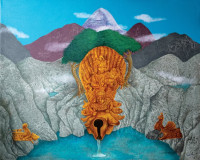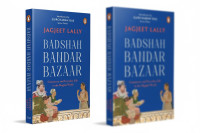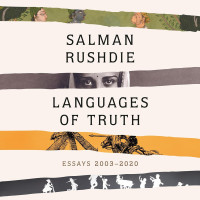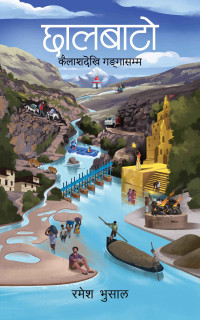Books
Secrets of a suppressed desire
Tulasi Acharya’s book discusses how sexual desire and patriarchy shape South Asian society, drawing from history, religion, and literature.Narayan Prasad Ghimire
Sex is a crucial element of a healthy, fulfilling life. Nevertheless, there is minimal discussion about it, which impedes creative ideas and practices related to a joyful sexual life. While sex is widely discussed in a gendered and sexualised society that targets and ridicules certain genders and groups, it is egregiously overlooked as a fundamental aspect of human life.
Furthermore, discussions about sex tend to satisfy men while playfully provoking women. This reflects a deeply ingrained tenet of sexuality, particularly in South Asia. A book written by Tulasi Acharya, titled ‘Sex, Desire, and Taboo in South Asia: Religion, Culture of Ability, and Patriarchy’, illuminates sex and sexuality, drawing references from the West to the East, as well as from ancient to modern times. It highlights the paradoxical treatment of sex and desire in Nepal and the broader South Asian context.
Writer Acharya explains the revered aspects of sex, presenting references to religion and divinity on one hand while, on the other, highlighting its status as a taboo in our culture. This juxtaposition reveals our hypocritical nature towards the unavoidable drive in life.
The sex manuals in South Asia, such as the ‘Kamasutra’ and ‘Kok Sashtra’, embody philosophical and spiritual aspects of sex, while George Bataille's ‘Eroticism’ enriches the book, igniting further debates on the drive appendage.
Similarly, the erotic arts, which are regarded as part of nature, can be further linked to aesthetics since ancient times. So, the erotic love reflected in the ‘menage a trois’ (three people in romantic or sexual relations) and ‘tundal’ (a small carved wood block) also finds space in the book.
Citing various books, the author says, “The love stories of Radha and Krishna unfold amidst tranquil landscapes. Nature serves as a setting for the lovers’ tales and facilitates the connection between erotic love and the divine.” The presence of ‘menage a trois’ in temples highlights the sacred and esteemed aspects of sexuality.
One of the significant features of this book is its assertion that sex reflects power dynamics, wherein patriarchal dominance prevails to keep women and other genders in the background. The sexual desires, drives, and urges of males are prioritised, while women’s sexual desires and urges, which are linked to power, are suppressed. In countries like Nepal and India, male domination is evident, as it is in politics, society, and the family.
In the theory of sexuality, the writer references Michel Foucault. According to Foucault, sexual repression is connected to the emergence of the bourgeoisie in the 17th century. ‘The desire to control talk and knowledge about sex was essentially a desire to control power, and this reflected on the different organisations and institutions where workers were trained about sex and sexual harassment while cementing the idea of sex as taboo directly or indirectly. Thus, sex was limited to the bedroom and was reduced to silence (Foucault 1990).’
Acharya points out that Foucault highlighted how early modern times were marked by sexual repression rooted in religious values, including bans on premarital sex, the control of female sexuality, taboos surrounding homosexuality, and the censorship of erotic art and literature from pre-modern eras.
Despite being titled ‘…South Asia’, the book offers insights into how perceptions of truth regarding sex and sexual life have evolved in the Western world. For example, diverse fields such as medicine, criminal justice, pedagogy, and psychiatry engaged in substantial discourse on sexuality during the 18th and 19th centuries, while sexual activities held both ethical and aesthetic significance in ancient Greece and Rome.
This research-focused book enhances the existing literature by exploring the taboo in prominent literary figures’ works, including BP Koirala and Parijat. The references from Nepali writers highlight how sex—a crucial element of human existence—remains suppressed and is often regarded as such despite its importance for human wellbeing. Through the works of Jhamak Ghimire and Parijat, the narrative showcases a challenge to the dominant gender and sexual norms within Nepali society.
In the chapter ‘Perception and Patriarchy’, the book discusses how patriarchy dominates perceptions of sex in South Asia. To substantiate this argument, the author analyses books by Indian writers and even films. This chapter exposes how male and female characters act and how male perspectives regulate female roles.
Selected literary works focusing on sexual and bodily experiences in South Asia are thoroughly analysed to enhance knowledge about sex and sexuality in the region. For instance, Jhamak Kumari Ghimire’s writings reveal that disability leads to mistreatment while females are already subjugated within Nepali society. Ghimire, as the author notes, deconstructed the traditional concept of sex as understood by able-bodied individuals.
Acharya has also underlined and interpreted other writers’ and thinkers’ observations and analyses on sex. One of the observations is on ‘The Joy of Sex’ by Alex Comfort. He regards it as a seminal text in the American context, arguing that it candidly talks about sex and its values in human life, brushing aside the issues of morality and immorality. The book advocates for “equality between sexes (male and females) and establishment of equalitarian society through equal plan and participation in sex.”
Similarly, the writer has suggested the theories of Bataille, Freud and Foucault for analysing sexual discourse in the South Asian context.
Moreover, the results of a survey on sex were presented, and respondents from Nepal and India were included. The survey covered themes such as sexual education, sexual experience, frequency of sexual activity, relationships, participation, premarital sex, and overall sexual health. It reinforces the idea that sexuality is an integral part of human life, regardless of age, and plays a significant role in one’s understanding of physical, emotional, and mental well-being.
In conclusion, the book reveals conflicting views on sex while also promoting its celebration as a means for equality and a fulfilling life. Encouraging discussions about sex and sexuality appears to be another aim of the book.
Ghimire is a journalist.
_____
Sex, Desire, and Taboo in South Asia
Author: Tulasi Acharya
Publisher: Lexington Books
Year: 2024




 14.12°C Kathmandu
14.12°C Kathmandu










